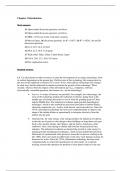Chapter 1 Introduction
Short answers:
1.1 Open-ended discussion question; see below.
1.2 Open-ended discussion question; see below.
1.3 HDI = 0.736; not in line with other countries
1.4 (a) see figure, (b) discussion question, (c) R2 = 0.457, (d) R2 = 0.0241, (e) and (f)
discussion questions
1.5 33.9, 29.5, 18.9, 23.0 EJ
1.6 98.6, 22.5, 38.8, 13.6 quads
1.7 Rank order: India, China, United States, Japan
1.8 140.4, 248, 22.3, 30.8, 81.9 mtoe
1.9 See explanation below.
Detailed answers:
1.1. Use the Internet or other resources to chart the development of an energy technology, from
its earliest beginnings to the present day. Did the roots of this technology first emerge prior to
the start of the industrial revolution? If so, how? If not, when did the technology first emerge?
In what ways did the industrial revolution accelerate the growth of the technology? More
recently, what has been the impact of the information age (e.g., computers, software,
electronically controlled operation, the Internet, etc.) on the technology?
Answer: A variety of answers are possible. For example, for wind energy, the
roots of the technology predate the industrial revolution, dating back to the
middle ages in Europe and earlier to use of wind for grinding grain in China
and the Middle East. The industrial revolution made possible metallurgical
techniques, which in turn enabled the precision fabrication of turbine blades,
electrical components, etc., used in wind electric conversion devices. Since the
1970s, information technology has been used computationally to improve the
shape of the turbine blades or operationally to integrate electricity from the
turbine into the grid.
Alternatively, for solar energy: solar energy predates the industrial revolution,
in that the use of passive solar design to heat buildings or keep them cool goes
back to the Ancient Greeks, the Chinese, and the Native Americans of the
southwest. Also, solar drying of clothes and food has been practiced since
antiquity. The industrial revolution accelerated the growth of solar energy by
making possible metallurgical techniques, which in turn enabled the precision
fabrication of experimental solar-powered, steam-driven devices starting in the
late 1800s. They also made possible home-sized solar water heating systems for
domestic hot water. Since the 1970s, information technology has been used
computationally to control the manufacture of solar panels, or to operate
tracking systems that optimize the position of solar panels relative to the sun.
, 1.2. Note to instructors: it may be preferable to provide the students with the raw data
for the three countries used in this exercise, if you wish to save them time on the data
gathering and focus on the calculations and analysis.
Solution: From studying the accompanying graphs, it is clear that the trend in the United
Kingdom more closely resembles that of the United States than that of China.
On the GDP side, both the United States and the United Kingdom have gradually been
decreasing energy and CO2 emissions per unit of GDP produced, although the United
Kingdom is somewhat more efficient than the United States in producing a unit of GDP.
This is different from China, which saw dramatic reductions in energy and CO2
emissions per unit of GDP between 1980 and 2000, although these are perhaps slowing
after 2000.
On the population side, energy consumption per capita is slightly up for the United
Kingdom and the United States and CO2 emissions per capita are slightly down for the
period in question. This suggests that both countries are reducing the amount of CO2 per
unit of energy consumed. China is much lower in per capita measures than the other two
countries, but is seeing an upturn in both since 2000, so that it appears that in the most
recent years, China is moving in a different direction than the other two countries. Since
1995 or so, China is growing a much larger middle class, so it is not surprising that
energy and CO2 might turn upward in this way.
In general, the shape of the figures varies little whether one compares the three
countries in terms of per unit of energy or per unit of CO2 emitted. The most profound
change has been the reduction in energy and CO2 per unit of economic activity in
China. Compared to this trend, all other measures have not changed as much.
Figures to accompany Problem 1.2:
120.0
100.0
80.0
GJ/$GDP
China
60.0 UK
USA
40.0
20.0
0.0
1980 1985 1990 1995 2000 2004




